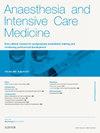Anaesthetic considerations for cardiac disease in pregnancy
IF 0.3
Q4 ANESTHESIOLOGY
引用次数: 0
Abstract
Cardiovascular disease remains one of the leading causes of pregnancy-related mortality in the developed world. Preconception counselling is essential to highlight individualized maternal, fetal, and cardiac risks. Pregnant individuals with a high-risk cardiac condition should be managed by a multidisciplinary cardio-obstetrics team comprising a high-risk obstetrician, cardiologist, neonatologist, and an anaesthetist in a tertiary centre. Anaesthetists as peripartum physicians need to comprehend the haemodynamic changes occurring during pregnancy, labour and postpartum period which can exacerbate pre-existing cardiac conditions resulting in haemodynamic compromise. Individualized patient care plans that incorporate risk-stratification, advice on timing, location, mode of delivery, haemodynamic monitoring, use of uterotonics, recommended analgesia/anaesthesia techniques along with postpartum follow-up are recommended to optimize maternal and fetal outcomes in individuals with cardiac disease in pregnancy. Anaesthesia and analgesia should be integral components of the core outcome set in studies reporting maternal and fetal outcomes in pregnant individuals with cardiac disease.
妊娠期心脏病的麻醉注意事项
在发达国家,心血管疾病仍然是妊娠相关死亡的主要原因之一。孕前咨询是必要的,以突出个性化的产妇,胎儿和心脏的风险。患有高危心脏病的孕妇应该由一个多学科的心产小组进行管理,该小组由三级中心的高危产科医生、心脏病专家、新生儿专家和麻醉师组成。麻醉师作为围产期医生需要了解在怀孕、分娩和产后期间发生的血流动力学变化,这些变化可能会加剧先前存在的心脏疾病,导致血流动力学损害。建议个体化患者护理计划,包括风险分层、时间、地点、分娩方式、血流动力学监测、子宫强张术的使用、推荐的镇痛/麻醉技术以及产后随访,以优化妊娠期心脏病患者的母婴结局。在报告患有心脏病的孕妇的母体和胎儿结局的研究中,麻醉和镇痛应该是核心结局集的组成部分。
本文章由计算机程序翻译,如有差异,请以英文原文为准。
求助全文
约1分钟内获得全文
求助全文
来源期刊

Anaesthesia and Intensive Care Medicine
ANESTHESIOLOGY-
CiteScore
0.50
自引率
0.00%
发文量
152
期刊介绍:
Anaesthesia and Intensive Care Medicine, an invaluable source of up-to-date information, with the curriculum of both the Primary and Final FRCA examinations covered over a three-year cycle. Published monthly this ever-updating text book will be an invaluable source for both trainee and experienced anaesthetists. The enthusiastic editorial board, under the guidance of two eminent and experienced series editors, ensures Anaesthesia and Intensive Care Medicine covers all the key topics in a comprehensive and authoritative manner. Articles now include learning objectives and eash issue features MCQs, facilitating self-directed learning and enabling readers at all levels to test their knowledge. Each issue is divided between basic scientific and clinical sections. The basic science articles include anatomy, physiology, pharmacology, physics and clinical measurement, while the clinical sections cover anaesthetic agents and techniques, assessment and perioperative management. Further sections cover audit, trials, statistics, ethical and legal medicine, and the management of acute and chronic pain.
 求助内容:
求助内容: 应助结果提醒方式:
应助结果提醒方式:


